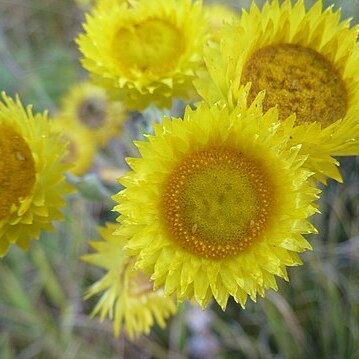Biennial herb, up to 1.5 m high; stem simple below inflorescence, glandular-setose, leafy. Leaves in a basal rosette in first year of growth; blade of basal leaves elliptic, up to 150(-250) x 60 mm, tapering to broad clasping base, glandular or thinly woolly; blade of stem leaves oblong to narrowly ovate, 65-130 x (15-)20-45 mm, smaller upwards, apex acute to acuminate, apiculate, base cordate clasping, main stem leaves decurrent in long or short wings; both surfaces glandular-setose, margins often white-woolly as well. Heads disciform, depressed-globose, (8-)10-12 x ± 15-25 mm, many in leafy, corymbose panicles. Involucral bracts in ± 9 series, slightly graded, imbricate, much exceeding florets, glossy bright yellow, radiating, stereome divided. Receptacle epaleate, shortly honeycombed. Flowers: female and disc florets ± 650-1200, 50-160 female; corolla of disc florets narrowly cylindric, yellow; Jan.-May, Oct. Fruit with cypsela (and ovary) glabrous. Pappus of many barbellate bristles, bases with patent cilia, lightly cohering or not.
Herb, up to 1.5 m high, aromatic, stem stout, simple, glandular-setose, inflorescence branches sometimes thinly white-cobwebby, leafy. Leaves: radical leaves absent at flowering, up to ± 250 mm long, elliptic, base broad, clasping, glandular or very thinly woolly; cauline leaves up to 130 mm long, smaller upwards, lanceolate, base cordate-clasping, both sides glandular-setose. Capitula depressed-globose, 8-12 mm long, 15-25 mm in diam., many in a large leafy, spreading, corymbose panicle; involucral bracts in ± 9 series, glossy, bright yellow. Flowers 650-1200. Flowering time Dec.-Apr. Pappus of many bristles, apex barbellate, bases with patent cilia. Cypselae 1 mm long, barrel-shaped.
Biennial herb, up to 1.5 m high. Radical leaves rosetted in first year of growth, up to 150(-250) x 60 mm, elliptic, glandular or thinly woolly; cauline 65-130 x (15-)20-45 mm, smaller upwards, oblong-lanceolate to lanceolate; main stem leaves decurrent in long or short wings, both surfaces glandular-setose, margins often white-woolly as well. Heads depressed-globose, 10-12 mm long, in leafy corymbose panicles. Flowers with glossy bright yellow involucral bracts.

